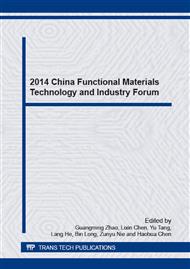[1]
O. Tegus, E. Bruck, K.H.J. Buschow and F.R. de Boer, Transition-metal-based magnetic refrigerants for room-temperature applications. Nature[J]. Vol. 415 (2002) p.150.
DOI: 10.1038/415150a
Google Scholar
[2]
F.X. Hu, B.G. Shen, J. R. Sun and Z. H. Chen, Influence of negative lattice expansion and metamagnetic transition on magnetic entropy change in the compound LaFe11. 4Si1. 6. J. Appl. Phys[J]. Vol. 78 (2001) No. 3, p.3675.
DOI: 10.1063/1.1375836
Google Scholar
[3]
V. K. Pecharsky and K. A. Gschneidner, Magnetocaloric effect and magnetic refrigeration. J. Magn. Magn. Mater[J]. Vol. 200 (1999) No. 1, p.44.
Google Scholar
[4]
A. Fujita, S. Fujieda, Y. Hasegawa and K. Fukamichi, Itinerant-electron metamagnetic transition and large magnetocaloric effects in La(FexSi1–x)13compounds and their hydrides. Phys. Rev. B[J]. Vol. 67 (2003) p.104416.
DOI: 10.1002/chin.200535243
Google Scholar
[5]
M. Balli, D. Fruchart and D. Gignoux, Optimization of La( Fe, Co)(13-x)Six based compounds for magnetic refrigeration. Journal of Physics: Condensed Matter[J]. Vol. 19 (2007) No. 23, p.236230.
DOI: 10.1088/0953-8984/19/23/236230
Google Scholar
[6]
Q.Y. Dong, H.W. Zhang, T.Y. Zhao, J.R. Sun and B.G. Shen, Realization of a small hysteresis loss and a large magnetic entropy change in NaZn13-type La–Fe–Si compound. Solid State Communications[J]. Vol. 147 (2008) No. 7-8, p.266.
DOI: 10.1016/j.ssc.2008.06.005
Google Scholar
[7]
Y.F. Chen, F. Wang, B.G. Shen, J.R. Sun, G.J. Wang, F. X. Hu, Z.H. Cheng and T. Zhu, Effects of carbon on magnetic properties and magnetic entropy change of the LaFe11. 5Si1. 5 compound. J. Appl. Phys[J]. Vol. 93 (2003) No. 10 p.6981.
DOI: 10.1063/1.1558658
Google Scholar
[8]
J. Lyubina, U. Hannemann, M. P. Ryan and L. F. Cohen, Electrolytic hydriding of LaFe13−xSix alloys for energy efficient magnetic cooling. Adv. Mater. [J]. Vol. 24 (2012) No. 15, p. (2042).
DOI: 10.1002/adma.201200112
Google Scholar
[9]
J. Lyubina, Recent advances in the microstructure design of materials for near room temperature magnetic cooling (invited). J. Appl. Phys[J]. Vol. 109 (2011) No. 7, p. 07A902.
DOI: 10.1063/1.3540372
Google Scholar
[10]
S. Fujieda, Y. Hasegawa, A. Fujita and K. Fukamichi, Thermal transport properties of magnetic refrigerants La(FexSi1–x)13 and their hydrides, and Gd5Si2Ge2 and MnAs. J. Appl. Phys [J]. Vol. 95 (2008) No. 5, p.2429.
DOI: 10.1063/1.1643774
Google Scholar
[11]
Y.F. Chen, F. Wang, B.G. Shen, F.X. Hu, Z.H. Chen, G.J. Wang and J.R. Sun, Large magnetic entropy change near room temperature in the LaFe11. 5Si1. 5H1. 3 interstitial compound. Chinese Physics[J]. Vol. 11 (2002) No. 7, p.741.
Google Scholar


